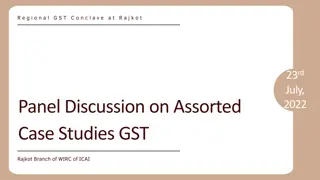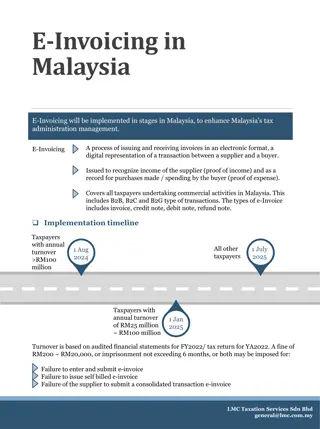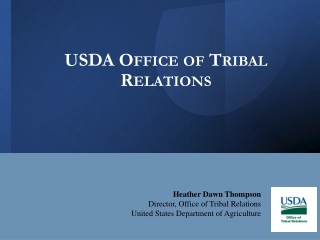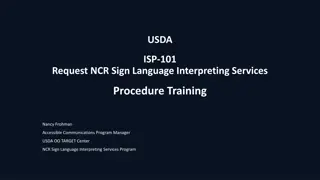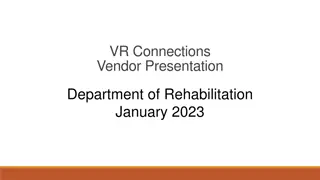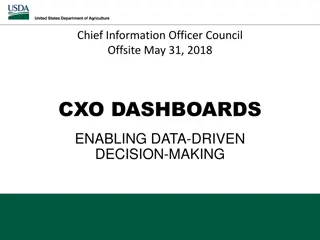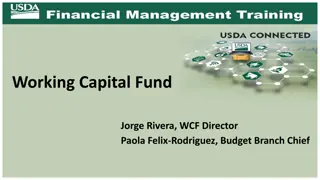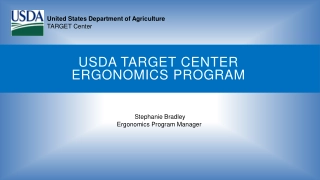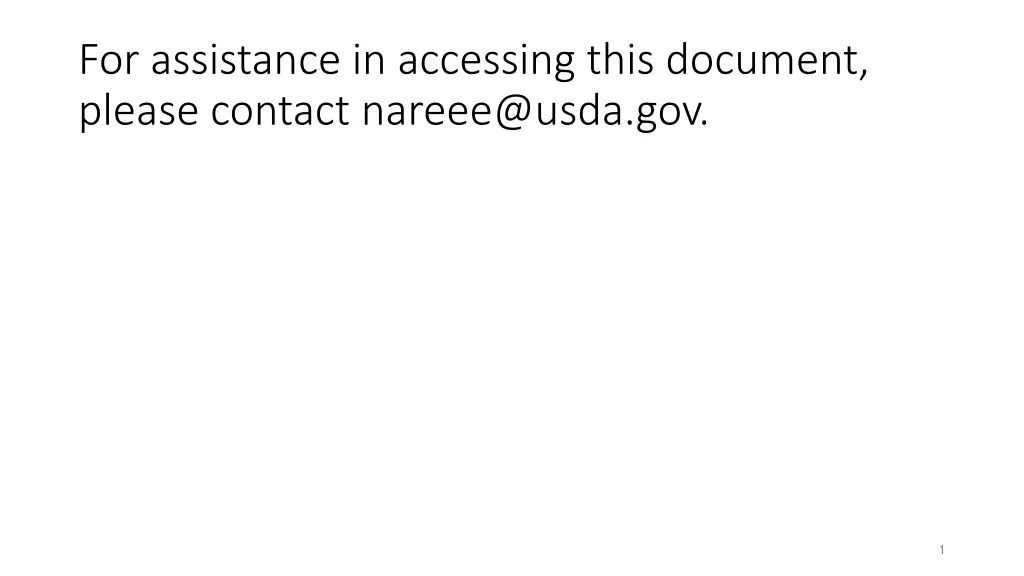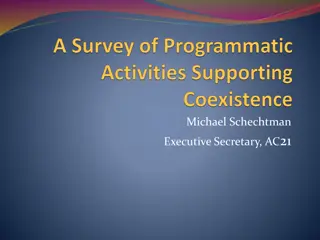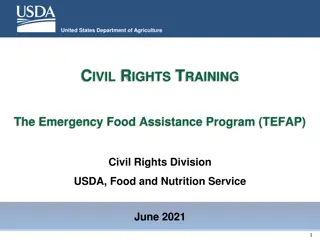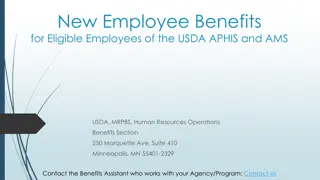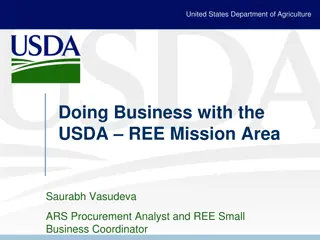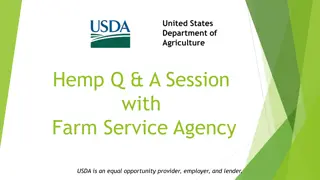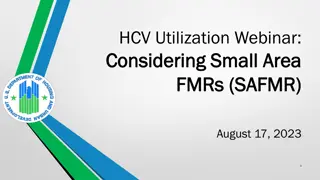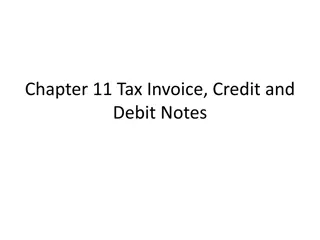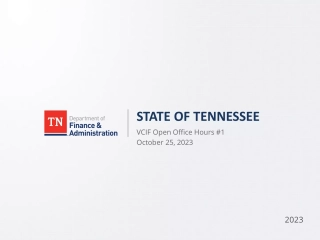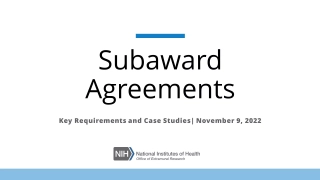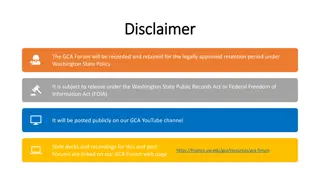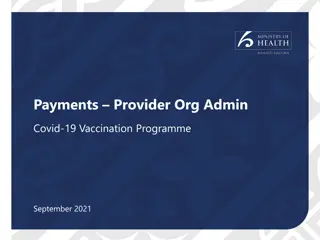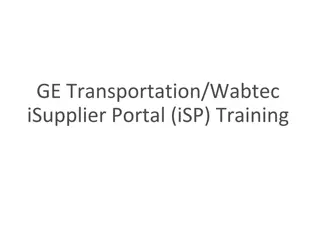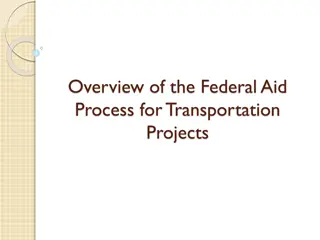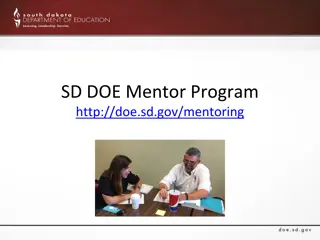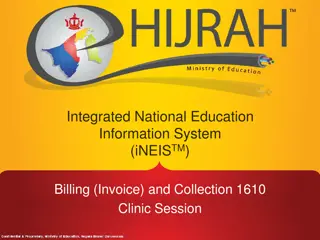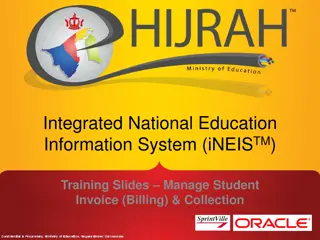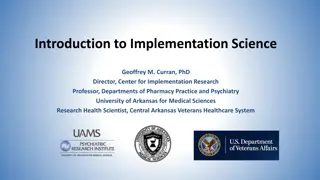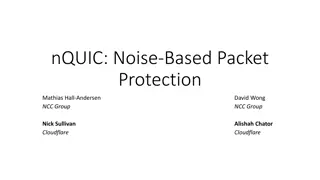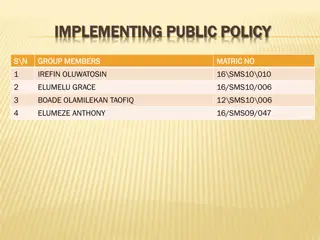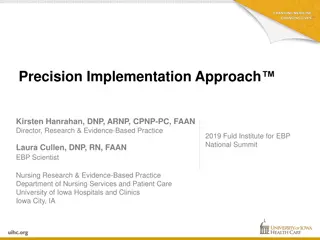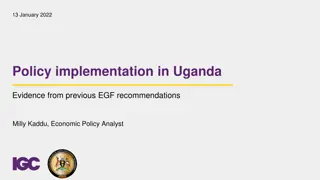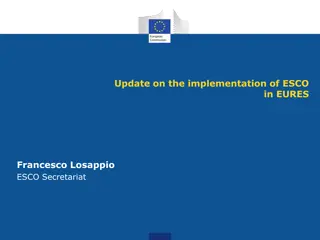Understanding G-Invoicing Implementation at USDA
G-Invoicing is an online portal facilitating electronic information exchange for interagency agreements among Federal agencies. The system streamlines invoicing processes, standardizes transactions, and enhances communication for reimbursable activities. The implementation at USDA involves mandatory adoption by all agencies by June 2021, with a focus on accessing, entering, and recording agreements efficiently using G-Invoicing.
Download Presentation

Please find below an Image/Link to download the presentation.
The content on the website is provided AS IS for your information and personal use only. It may not be sold, licensed, or shared on other websites without obtaining consent from the author. Download presentation by click this link. If you encounter any issues during the download, it is possible that the publisher has removed the file from their server.
E N D
Presentation Transcript
G-Invoicing Impacts to USDA Users Eddie Reso
What is G-Invoicing? Online portal for Interagency Agreements serves as the broker Mechanism by which agencies arrange and negotiate information electronically A data exchange platform common to ALL Federal Agencies Facilitates the exchange of information between Federal trading partners Has well-defined lines of communication, and is the origin for sharing data and exchanging information on reimbursable activity
G-Invoicing - 4 Parts Part 1 The Agreement Form 7600A: General Terms and Conditions (GT&C) Agreement Part 2 Placing Orders Form 7600B: Order and Funding Part 3 Performance Invoicing for Goods or Services Provided Standardized Seller-Generated Interagency Invoice Part 4 Settlement Invoicing and Payment G-Invoicing will create IPAC transactions (terms pre-defined in GT&C) Terms can specify, automatic IPAC upon invoicing, or require approval
G Invoicing High Level Overview
G-Invoicing Implementation Mandatory for all Federal Agencies All Federal Agencies must me implemented into G-Invoicing by June 2021 USDA is currently developing implementation plan Agreements between USDA Agencies will NOT be in G-Invoicing Intra-USDA agreements will be recorded in the newly developed IAA Module of the EZFedGrants system, which is interfaced to FMMI The new USDA-IAA process for Intra-USDA agreements will continue to utilize the current FMMI internal INTR Process for recording payments and collections
Step 1 The Agreement USDA FMMI Agencies will use the G-Invoicing portal for entering agreements Obtain access from Treasury Fiscal Service Federal trading partners must also be in G-Invoicing to complete agreement USDA plans for G-Invoicing Agreement data to be pulled from G-Invoicing and interfaced into FMMI. G-Invoicing will be the data entry point for agreements
Step 2 The Orders USDA s initial vision is for agencies not to enter orders in G-Invoicing Enter the Purchase Order in FMMI as done today, for all orders An interface will be built to transmit Purchase Order Data to/from FMMI to G-Invoicing Special Notes about CARS and Component TAS G-Invoicing does not support String TAS Although FMMI still uses String TAS s - Application of Funds, this is only for front-end user convenience. Behind the scenes the component TAS is stored and transmitted to Treasury for reporting. USDA Users will need to be familiar with the component TAS format
Step 3 Performance/Invoicing USDA s initial vision is for agencies not to enter performance data in G-Invoicing G-Invoicing Order Data from USDA customer agencies will be downloaded from G-Invoicing An interface will be built to use G-Invoicing Order data to create Sales Orders in FMMI As goods and services are delivered, resource related billing will run as currently done to produce AR Invoices An interface will be built to extract and send FMMI Billing Data to G-Invoicing to record performance
Step 4 Settlement In Regards to USDA as the Vendor/Performing Agency: G-Invoicing will receive data from FMMI to record performance G-Invoicing system will trigger IPAC transactions to accomplish collections Settlement terms recorded on established agreements will dictate when the IPAC collections are generated: FOB Shipping IPAC transactions will be automatically generated FOB Destination Customer agency will have to manually approve invoice in the G-Invoicing portal before IPAC transactions will be generated Collection confirmation data will be available from both G-Invoicing and IPAC systems for downloading and recording in FMMI
Step 4 Settlement (cont.) In Regards to USDA as the Customer/Receiving Agency: The USDA Trading Partner will record performance data in G-Invoicing G-Invoicing system will trigger IPAC transactions based on GT&C Terms USDA will download IPAC disbursement transactions from either the G-Invoicing or IPAC systems IPAC transactions will be loaded to FMMI and matched against Purchase Orders to record Accounts Payable invoices and cash disbursements as currently done
Summary of Implementation Status Decision made USDA agencies will utilize the G-Invoicing Portal for entering agreement data USDA will not use on-line portal for entering ordering and performance data, but rather electronically load this data, as suggested by Fiscal Service SAP must provide solution for its Federal customers SAP is currently working with its Federal customer agencies to gather requirements, address concerns, and provide demonstrations on protypes
Whats Next Gain access now to G-Invoicing Portal Schedule live training in Crystal City, VA or Webex Training Questions
Live Demo Lena Napolitano Federal Reserve Bank St. Louis
G-Invoicing System Environments QA-C PROD Quality Assurance Current (QA-C) URL: https://qa.igt.fiscal.treas ury.gov/ Production (Prod) URL: https://www.igt.fiscal.tr easury.gov/ The U.S. Department of the Treasury, Bureau of the Fiscal Service policy prohibits the use/storage of production (real) data in non- production QA-C (test) environment Please modify the data so there is no real data in QA-C
G-Invoicing System Modules Trading Partners GT&C Agreements Orders Performance IPAC Status for Funds Settlement Intra-Gov Disburser Account Configuration Reference data management and maintenance of data access groups Creation of users Assignment of roles and data access groups Disburser Administrator
G-Invoicing Implementation Work with the Agency Implementation Team (AIT) Leads Identify your stakeholders for G-Invoicing implementation Establish Working Groups Review reference materials on G-Invoicing Fiscal Service Website Compare your IGT As-Is Model to the Federal IGT Data Standards Identify SMEs involved in IGT (Support Agreements Managers, Orders, 7600A/B Forms, DISB/COLL, IPAC) Establish data access groups and users in G-Invoicing QA and Production environments Prepare Implementation Project Plan Work with your software provider(s) to comply with G-Invoicing and FIDS requirements Join the Intragovernmental Transactions Working Group (ITWG) meetings Sign up by e-mailing IGT@fiscal.treasury.gov IGT@fiscal.treasury.gov
G-Invoicing User Training Train the Trainer approach for training of initial agency users Onsite training of Admins and Users Training material are available to support training approach Computer Based Training (CBTs) Available on Fiscal Service Website Creating a GT&C Creating an Order Establishing an Access Model Structure Signup available on Fiscal Service Website for: G-Invoicing Workshops in Crystal City, VA and Webinars https://www.fiscal.treasury.gov/g-invoice/training.html https://www.fiscal.treasury.gov/g-invoice/training.html
G-Invoicing Treasury Contact Information For IGT Program Management and Agency Outreach Support Chris Beck Manager, General Ledger and Advisory Branch, Bureau of the Fiscal Service (304) 480-7122; christopher.beck@fiscal.treasury.gov Keith Jarboe IGT Agency Outreach Engagement & Onboarding Staff Bureau of the Fiscal Service Fiscal Accounting 202-874-7818; keith.jarboe@fiscal.treasury.gov christopher.beck@fiscal.treasury.gov keith.jarboe@fiscal.treasury.gov For Intragovernmental Transactions Working Group Information IGT@fiscal.treasury.gov IGT@fiscal.treasury.gov Alex Abshire (alexander.abshire@fiscal.treasury.gov) Wesley Vincent (wesley.vincent@fiscal.treasury.gov) https://www.fiscal.treasury.gov/g-invoice/ alexander.abshire@fiscal.treasury.gov wesley.vincent@fiscal.treasury.gov https://www.fiscal.treasury.gov/g-invoice/ For Intragovernmental Reporting Point of Contact List for Agencies https://www.fiscal.treasury.gov/gtas/intergovernmental-contact-list-for-agencies.html https://www.fiscal.treasury.gov/gtas/intergovernmental-contact-list-for-agencies.html The Financial Reports Division has provided each agency with an assigned review accountant to answer questions about the Intragovernmental Transactions (IGT)
G-Invoicing Implementation Team Agency Onboarding and Implementation, Federal Reserve Bank of St. Louis Robert Mattison, AIT Manager George Pierce, AIT Lead Robert.Mattison@stls.frb.org (314) 444-3943 Robert.Mattison@stls.frb.org George.Pierce@stls.frb.org (202) 759-0701 George.Pierce@stls.frb.org Doug Larson, Senior Project Manager Will Beedie, AIT Specialist Douglas.Larson@stls.frb.org (202) 759-0700 Douglas.Larson@stls.frb.org William.Beedie@stls.frb.org (314) 444-8797 William.Beedie@stls.frb.org Lena Napolitano, AIT Lead Shelley Sadler, AIT Specialist Olena.Napolitano@stls.frb.org (202) 759-0702 Olena.Napolitano@stls.frb.org Shelley.Sadler@stls.frb.org (314) 444-3969 Shelley.Sadler@stls.frb.org If you need your password to be reset, please contact Treasury Support Center at e-mail: GInvoicing@stls.frb.org and/or phone: (877)-440-9476, Monday Friday, 7:00am - 8:00pm GInvoicing@stls.frb.org
G-Invoicing System Demo https://qa.igt.fiscal.treasury.gov/ https://qa.igt.fiscal.treasury.gov/
Implementation Plan G-invoicing General Services Administration Robert Smalskas
GSA is a major seller GSA is a major seller Multiple Business lines Public Buildings Service Federal Acquisition Service Office of Governmentwide Policy Others High dollars and large volume of agreements Business area Rent Reimbursable Work Authorizations Assisted Acquisition Vehicle Leasing Supply Annual Revenue Number of agreements $9.4B $1.6B $8.8B $1.7B $937M 19,200 9,250 12,500 30,200 1,200,000
GSA G GSA G- -invoicing Implementation Plan invoicing Implementation Plan Currently GSA has several approaches for intergovernmental transactions Buy/Sell: Formal Agreements (Assisted Acquisition, Reimbursable Work) Recurring Services (Rent, Vehicle Leasing, Telecom) Requisition Services (Supplies) The three approaches require different actions in the implementation plan.
Formal Agreements Formal Agreements Upload existing agreements Customers continue to use GSA portals GSA, through an interface, uploads orders to G-invoicing on the customer s behalf
Recurring Services Recurring Services Rent, Vehicle Leasing Create GT&C - based on Agency Location Code using the services. GSA creates orders in G-invoicing on the customer s behalf GSA creates performance records monthly Telecom New business model. Enterprise Infrastructure Solutions (EIS) contract agencies pay vendor directly and will not utilize G-Invoicing
Requisition Services Requisition Services Customers order through online eCommerce systems, phone calls or at a retail store. No formal agreement Validation process in place Customers continue to use sales portals Millions of automated transactions per year Inserting G-invoicing approvals into the process could negatively impact timeliness Exploring options - export data to G-Invoicing


